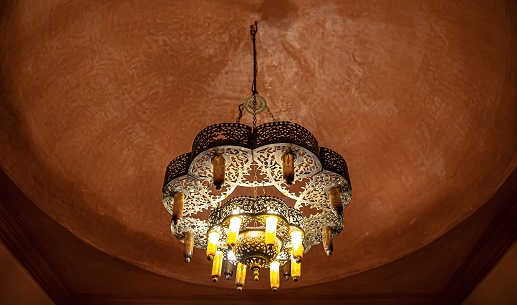July 03, 2025 | 13 days ago

Lighting has a massive impact on the way we feel in an area. The correct light can make a room feel comfortable, spacious, classy, or contemporary. Although there are a wide variety of ceiling lighting solutions that are available today, two of the most widely used options that people usually weigh up are pendant lights and chandeliers.
Both are used to add style, personality, and function to different parts of the home. But when it comes to choosing lighting for home, understanding the difference between these two is important. In this blog, we’ll break down what each of them is, their pros and cons, and how to pick the right one for your space.
Pendant lights are ceiling-suspended light fixtures, typically suspended by a cord, rod, or chain. They consist of a single light bulb housed within a decorative casing or shade. Due to their small space requirement and uncomplicated design, pendant lights work well for task lighting and accent lighting.
Pendant lights are extremely versatile. They are used commonly:
You can install them in a series or incorporate just one, depending on the area.
You will come across contemporary lighting fixtures in different finishes such as brass, copper, matte black, or chrome. Pendant lights also come in materials such as:
No matter your home aesthetic is minimalist, industrial, vintage, or bohemian, there's a decorative lighting chandelier style to suit.
A chandelier is a suspended light, but it's even more formal than a pendant. Chandeliers typically feature several arms or branches, each of which can contain a bulb of its own. They are frequently utilized as showy centerpieces and are characterized by their rich, opulent appearance.
Chandeliers are ideal in:
They provide a touch of drama, tradition, or glamour depending on the style you select.
There are numerous kinds of chandeliers that can be found in the market:
In the realm of decorative lighting , chandeliers are generally the epitome of sophistication and can be found in upscale environments.
When comparing pendant lights vs. chandeliers, there are a few key areas where they contrast:
It is through recognizing the difference between pendant lights and chandeliers that you make the decision based on your room, ceiling height, and design choice.
If you’re looking for ceiling lighting options that are practical and stylish, pendant lights are a fantastic choice. They are best for:
They're also perfect if you need several light points in a room. For instance, three pendant lights above a kitchen island can ensure uniform lighting and amplify the contemporary appearance.
Pendant lights don't overwhelm the decor, so they're perfect for minimalist designs and can be installed in many different spaces.
Chandeliers are ideal for creating a strong impact. Select a chandelier when:
A chandelier brings instant sophistication and lays the foundation for a room. Even a plain-looking modern lighting fixture can provide a chic touch to a modern room.
Should you opt for pendant lights or a chandelier? Here's a quick comparison to help you make up your mind:
Room Size Small to medium Medium to large
Ceiling Height Low to standard Medium to high
Style Modern, minimalist, informal Grand, elegant, formal
Functionality Task and ambient lighting Decorative and ambient
Cost Budget-friendly, affordable More costly, considered an investment
Ease of Install Simple to install and maintain Requires more planning and support
If you're creating a space from the ground up or doing a makeover, keep in mind that pendant lights vs. chandeliers is not necessarily an either-or decision. In bigger houses, having both kinds in different rooms can be an attractive design scheme.
The following are tips on how to style your lighting fixtures according to your home décor:
At Foslighting, we provide a range of styles, including pieces from the decorative lighting range. From minimalist pendant to vintage chandelier, our designs cater to all tastes.
Ultimately, both pendant lights and chandeliers can add life to your interiors. The trick lies in understanding what each has to offer and how they can work with your space. If you require lighting that's functional, chic, and minimalist, choose pendant lights. If you want to create elegance and a wow factor, chandeliers are your go-to.
The difference between pendant lights and chandeliers is in their design, function, and effect. Both have a place in contemporary homes, and the best among them for you would be based on your room, budget, and taste.
Scroll through Foslighting's handpicked selection of ceiling lighting options and discover the best decorative lighting designs. From sophisticated chandeliers to modern pendant lights, we have just the right light for each room in your house.

Lighting the Readers’ Way: Recreating and Lighting Up a Cozy Corner for the Readers
August 18, 2023
Outdoor Monsoon Lights: Warming Up the Outdoors with a Softness
August 25, 2023
A Comprehensive Guide to Choosing Ceiling Lights for Your Kitchen
September 12, 2023
Illuminating Style: Unlocking Leather's Luxury with the Perfect Light Fixtures
December 29, 2023
Fos Lighting: The Enduring Allure of Antique & Vintage Lighting – Timeless Design for Modern Homes
June 09, 2025